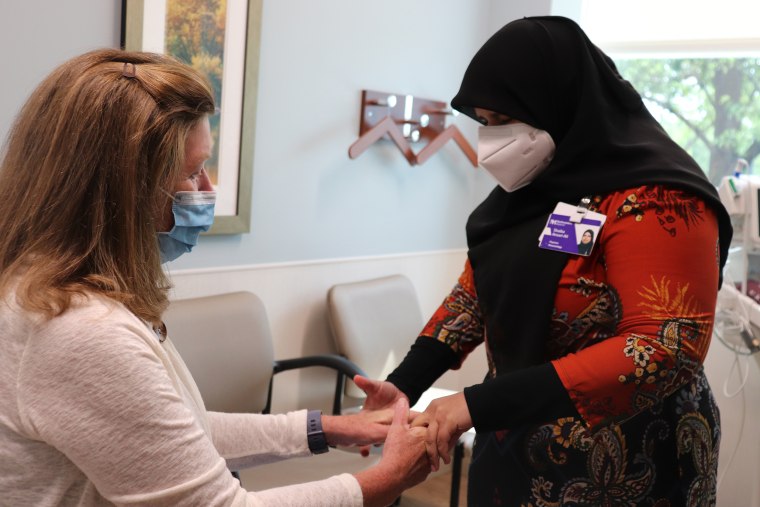A chronic cough caused Dr. Shaiba Ansari-Ali, a rheumatologist at Northwestern Medicine Delnor Hospital in Geneva, Illinois, to suffer a rare and particularly deadly type of stroke when she was 42. She also experienced locked-in syndrome, a period of time where she was aware of what was happening but appeared unconscious to others. Ansari-Ali, author of "When the Doctor Has a Stroke," shared her recovery story with TODAY.

I had a cough for about four years and it was happening nonstop for about four to six months of the year. I'd get a virus in August and cough my way through December, and then maybe pick up a virus in December and cough my way through spring. It was an intense cough and sometimes my rib cage would hurt after an episode.
Looking back, I had cough-variant asthma, but at the time, I didn't know what it was. I'd be coughing about every two minutes while I was awake. But in the evening, it was almost gone and I'd be able to sleep OK. It would go away after a few months, so every time I thought I’d get it checked out, it would be gone.
The stroke happened on the morning of July 1, 2016. I was at home and sat down at my computer. Suddenly, the room just started to spin and it was very weird. Not only did it spin round and round, but up and down. It was like being on the worst roller coaster ever.
I realized I couldn't stand up straight. So I lurched from the guest bedroom to the main bedroom and told my husband, “The room is spinning. I'm very dizzy,” and he said, “This is probably one of your migraines.”
Then I went to the bathroom and threw up. Sometimes with migraines, I feel better after I throw up, but I didn't feel better. I lay on the floor of the bathroom and realized I couldn't move. I could feel everything and process everything, I just couldn't move anything.

I thought, “Wow, I'm having a stroke.” I actually knew where in the brain it was. So I was like, “Oh, I’m having a basilar artery stroke and I have limited blood to the internal capsule,” which is the part of the brain that lets you move.
I later learned I had a vertebral artery dissection that led to the stroke. That's just a fancy way of saying that the blood vessels that go to the brain, the two big ones in the back, the lining on the inside had kind of sheared away. Like if you have a pipe and the lining shears away and falls in on itself, anything that's going through that pipe is now going to be blocked. About 85% of people who have this type of stroke die before they get to the hospital.
Normally, a stroke is caused by high blood pressure or diabetes or having a disease that gives you blood clots, but the vertebral artery dissection is more of a mechanical thing. It can happen with weird sudden movements — like severe whiplash during a car accident. In my case, if you're coughing all the time, your neck is under a lot of stress. That area just keeps getting pummeled.
The locked-in syndrome started when I was on the bathroom tile. When my husband saw me, he thought I was unconscious, but I knew exactly what was happening.
I know this is weird, but I had no fear. On the inside, I was super funny, funnier than I've ever been. I was Ryan Reynolds in “Deadpool” — that's the exact voice I was on the inside. I was also very objective and analytical. It was like I could live stream the stroke in a very optimistic, funny way.
The ambulance people didn't know I was awake because they kept doing sternum rubs that really hurt — you rub really hard on the breastbone of a patient to assess consciousness. The first doctor also didn’t know, but the neurologist knew pretty quickly I was having a stroke.
The locked-in syndrome ended when I got the very strong blood thinner TPA in the emergency room. I felt this jolt of electricity go through me and then suddenly I could move my right side again. I was sedated and intubated. I could not feel, but I could see and process everything, but everybody else thought I was asleep or in a coma.
After they reversed the sedation and extubated me, I was able to meet with family for a few minutes. I thought I was communicating clearly, but everybody said my voice was garbled. I could feel all my extremities and knew I could move them, but I felt dead tired.
I did a few weeks of inpatient rehab and then recovered at home for about two months. Those first three months are super critical. Whatever you're going to get back after a stroke, you can get it back the most easily within that time. So I just focused on rehab and didn't allow any visitors. I come from a big Indian family and they were almost breaking down the doors to come in and see me.

Today, I have an asthma doctor and my cough is controlled. I'm on the blood thinner Plavix for life. I try to stay active and not stress myself out too much.
In the mornings when I'm fresh, I feel 90% of how I did before. But when I get tired, my speech becomes garbled, I'll start to limp a little and I’ll choke on foods more because I can't swallow very well.
After this experience, I always make sure I'm optimistic for my patients because when I was in rehab, the doctors were always optimistic. I tell patients to focus on what they can do. Don't go day by day but month to month. If this month is better than the month before, you're on the right track.
We were always trained in med school to introduce yourself to a patient who is intubated and sedated and explain what you are going to do. Now I can see how important it is.
This interview was edited and condensed for clarity.

